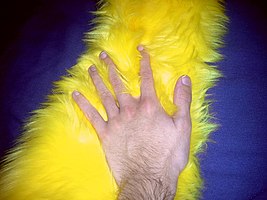
Back سلوك التحفيز الذاتي Arabic Autoestimulació Catalan Sebestimulace Czech Stimming (Psychologie) German Autoestimulación (comportamiento) Spanish Autoestimulazio (portaera) Basque Auto-stimulation French חשחוש HE Ինքնախթանում Armenian Stimming Italian

Self-stimulatory behavior, also known as "stimming"[1] and self-stimulation,[2] is the repetition of physical movements, sounds, words, moving objects, or other behaviors. Such behaviors (also scientifically known as "stereotypies") are found to some degree in all people, especially those with developmental disabilities such as ADHD, as well as autistic people.[2] People diagnosed with sensory processing disorder are also known to potentially exhibit stimming behaviors.[3]
Stimming has been interpreted as a protective response to overstimulation, in which people calm themselves by blocking less predictable environmental stimuli, to which they have a heightened sensitivity.[2][3] A further explanation views stimming as a way to relieve anxiety and other negative or heightened emotions.[4]

Although some stimming behaviors have been shown to be healthy and beneficial—as they help regulate intense feelings—[5][6] stimming is often socially stigmatized and looked down upon. People who are neurodivergent often feel that they need to hide or decrease their self-stimulatory behavior, as it appears to not be socially acceptable, and often elicits an undesirable response from those who do not understand the compulsion behind them. There are also potential mental health and well-being risks in suppressing and masking autistic stimming behaviors that are harmless or adaptive.[7][6][5][8][9]
Stimming behaviors can consist of tactile, visual, auditory, vocal, proprioceptive (which pertains to limb sensing), olfactory, and vestibular stimming (which pertains to balance). Some common examples of stimming (sometimes called stims[10]) include hand flapping, clapping, rocking, blinking, pacing, head banging, repeating noises or words, snapping fingers, and spinning objects.[11][12] In some cases, stimming may be dangerous and physically harmful to the person doing it; for example, individuals may risk injuring themselves by forcefully banging their body parts against walls.[13]
- ^ Rosalind Bergemann (2013). An Asperger Leader's Guide to Living and Leading Change. Jessica Kingsley Publishers. ISBN 978-0-85700-872-5.
- ^ a b c Valerie Foley (2011). The Autism Experience. ReadHowYouWant.com. ISBN 978-1-4587-9728-5.
- ^ a b Gretchen Mertz Cowell (2004). Help for the Child with Asperger's Syndrome: A Parent's Guide to Negotiating the Social Service Maze. Jessica Kingsley Publishers. ISBN 978-1-84642-042-9.
- ^ Eileen Bailey (15 July 2011). "Autism Spectrum Disorders and Anxiety". Health Central. Retrieved 25 March 2014.
- ^ a b Charlton, Rebecca A.; Entecott, Timothy; Belova, Evelina; Nwaordu, Gabrielle (2021). ""It feels like holding back something you need to say": Autistic and Non-Autistic Adults accounts of sensory experiences and stimming". Research in Autism Spectrum Disorders. 89: 101864. doi:10.1016/j.rasd.2021.101864. S2CID 240532683.
- ^ a b Collis, E.; Gavin, J.; Russell, A.; Brosnan, M. (February 2022). "Autistic adults' experience of restricted repetitive behaviours". Research in Autism Spectrum Disorders. 90: 101895. doi:10.1016/j.rasd.2021.101895. S2CID 244869197.
- ^ Kapp, Steven K; Steward, Robyn; Crane, Laura; Elliott, Daisy; Elphick, Chris; Pellicano, Elizabeth; Russell, Ginny (28 February 2019). "'People should be allowed to do what they like': Autistic adults' views and experiences of stimming". Autism. 23 (7): 1782–1792. doi:10.1177/1362361319829628. ISSN 1362-3613. PMC 6728747. PMID 30818970.
- ^ McCormack, Lynne; Wong, Sze Wing; Campbell, Linda E. (4 July 2022). "'If I don't Do It, I'm Out of Rhythm and I Can't Focus As Well': Positive and Negative Adult Interpretations of Therapies Aimed at 'Fixing' Their Restricted and Repetitive Behaviours in Childhood" (PDF). Journal of Autism and Developmental Disorders. 53 (9). Springer Science and Business Media LLC: 3435–3448. doi:10.1007/s10803-022-05644-6. ISSN 0162-3257. PMC 10465631. PMID 35781855.
- ^ Waizbard-Bartov, Einat; Ferrer, Emilio; Heath, Brianna; Andrews, Derek S.; Rogers, Sally; Kerns, Connor M.; Wu Nordahl, Christine; Solomon, Marjorie; Amaral, David G. (2023). "Changes in the severity of autism symptom domains are related to mental health challenges during middle childhood". Autism. doi:10.1177/13623613231195108. PMC 10924781. PMID 37691349. S2CID 261679577.
- ^ Temple Grandin, PhD (November 2011). "Why Do Kids with Autism Stim?". Autism Digest. Archived from the original on 31 March 2014. Retrieved 25 March 2014.
- ^ Eileen Bailey (27 August 2012). "Stimming". Health Central. Retrieved 25 March 2014.
- ^ "Stimming: What autistic people do to feel calmer". BBC. 5 June 2013. Retrieved 25 March 2014.
- ^ Smith, Lori; Legg, Timothy J. (19 February 2018). "What is stimming?". Medical News Today. Retrieved 19 April 2022.
For some, stimming can include higher-risk behaviors such as banging their hands, head, legs, and objects, which may be potentially physically harmful.
© MMXXIII Rich X Search. We shall prevail. All rights reserved. Rich X Search